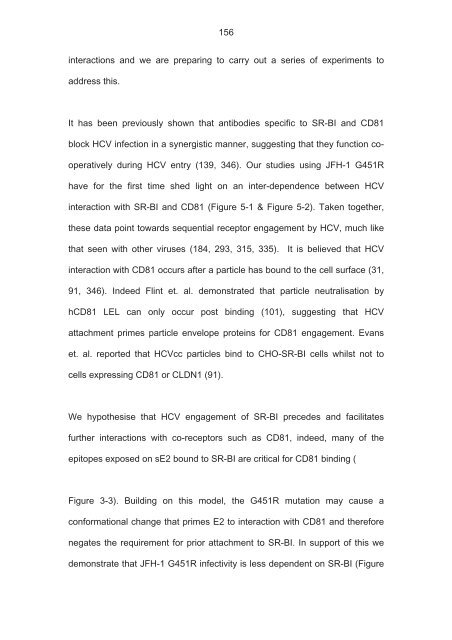The role of scavenger receptor BI in hepatitis - eTheses Repository ...
The role of scavenger receptor BI in hepatitis - eTheses Repository ...
The role of scavenger receptor BI in hepatitis - eTheses Repository ...
Create successful ePaper yourself
Turn your PDF publications into a flip-book with our unique Google optimized e-Paper software.
156<br />
<strong>in</strong>teractions and we are prepar<strong>in</strong>g to carry out a series <strong>of</strong> experiments to<br />
address this.<br />
It has been previously shown that antibodies specific to SR-<strong>BI</strong> and CD81<br />
block HCV <strong>in</strong>fection <strong>in</strong> a synergistic manner, suggest<strong>in</strong>g that they function co-<br />
operatively dur<strong>in</strong>g HCV entry (139, 346). Our studies us<strong>in</strong>g JFH-1 G451R<br />
have for the first time shed light on an <strong>in</strong>ter-dependence between HCV<br />
<strong>in</strong>teraction with SR-<strong>BI</strong> and CD81 (Figure 5-1 & Figure 5-2). Taken together,<br />
these data po<strong>in</strong>t towards sequential <strong>receptor</strong> engagement by HCV, much like<br />
that seen with other viruses (184, 293, 315, 335). It is believed that HCV<br />
<strong>in</strong>teraction with CD81 occurs after a particle has bound to the cell surface (31,<br />
91, 346). Indeed Fl<strong>in</strong>t et. al. demonstrated that particle neutralisation by<br />
hCD81 LEL can only occur post b<strong>in</strong>d<strong>in</strong>g (101), suggest<strong>in</strong>g that HCV<br />
attachment primes particle envelope prote<strong>in</strong>s for CD81 engagement. Evans<br />
et. al. reported that HCVcc particles b<strong>in</strong>d to CHO-SR-<strong>BI</strong> cells whilst not to<br />
cells express<strong>in</strong>g CD81 or CLDN1 (91).<br />
We hypothesise that HCV engagement <strong>of</strong> SR-<strong>BI</strong> precedes and facilitates<br />
further <strong>in</strong>teractions with co-<strong>receptor</strong>s such as CD81, <strong>in</strong>deed, many <strong>of</strong> the<br />
epitopes exposed on sE2 bound to SR-<strong>BI</strong> are critical for CD81 b<strong>in</strong>d<strong>in</strong>g (<br />
Figure 3-3). Build<strong>in</strong>g on this model, the G451R mutation may cause a<br />
conformational change that primes E2 to <strong>in</strong>teraction with CD81 and therefore<br />
negates the requirement for prior attachment to SR-<strong>BI</strong>. In support <strong>of</strong> this we<br />
demonstrate that JFH-1 G451R <strong>in</strong>fectivity is less dependent on SR-<strong>BI</strong> (Figure

















